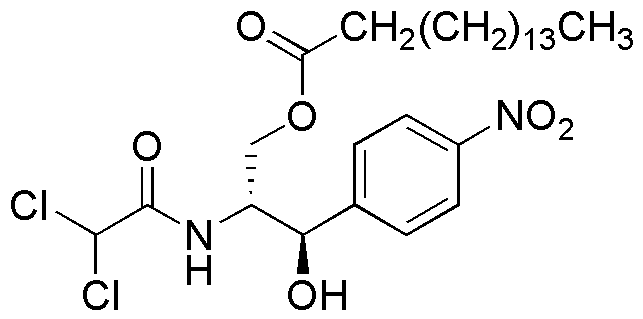Chloramphenicol palmitate is widely utilized in research focused on
- Pharmaceutical Development: This compound is often used in the formulation of oral medications, especially for pediatric patients, due to its palmitate ester form which enhances solubility and absorption.
- Antibiotic Research: It serves as a model compound in studies aimed at understanding antibiotic resistance mechanisms, helping researchers develop more effective treatments.
- Veterinary Medicine: Chloramphenicol palmitate is used in veterinary applications to treat bacterial infections in animals, providing a crucial alternative when other antibiotics are ineffective.
- Drug Delivery Systems: The compound is explored in the development of novel drug delivery systems, allowing for targeted release and improved therapeutic outcomes.
- Analytical Chemistry: It is employed in analytical methods to quantify chloramphenicol levels in biological samples, ensuring safety and compliance in pharmaceutical manufacturing.
General Information
Properties
Safety and Regulations
Applications
Chloramphenicol palmitate is widely utilized in research focused on
- Pharmaceutical Development: This compound is often used in the formulation of oral medications, especially for pediatric patients, due to its palmitate ester form which enhances solubility and absorption.
- Antibiotic Research: It serves as a model compound in studies aimed at understanding antibiotic resistance mechanisms, helping researchers develop more effective treatments.
- Veterinary Medicine: Chloramphenicol palmitate is used in veterinary applications to treat bacterial infections in animals, providing a crucial alternative when other antibiotics are ineffective.
- Drug Delivery Systems: The compound is explored in the development of novel drug delivery systems, allowing for targeted release and improved therapeutic outcomes.
- Analytical Chemistry: It is employed in analytical methods to quantify chloramphenicol levels in biological samples, ensuring safety and compliance in pharmaceutical manufacturing.
Documents
Safety Data Sheets (SDS)
The SDS provides comprehensive safety information on handling, storage, and disposal of the product.
Product Specification (PS)
The PS provides a comprehensive breakdown of the product’s properties, including chemical composition, physical state, purity, and storage requirements. It also details acceptable quality ranges and the product's intended applications.
Certificates of Analysis (COA)
Search for Certificates of Analysis (COA) by entering the products Lot Number. Lot and Batch Numbers can be found on a product’s label following the words ‘Lot’ or ‘Batch’.
*Catalog Number
*Lot Number
Certificates Of Origin (COO)
This COO confirms the country where the product was manufactured, and also details the materials and components used in it and whether it is derived from natural, synthetic, or other specific sources. This certificate may be required for customs, trade, and regulatory compliance.
*Catalog Number
*Lot Number
Safety Data Sheets (SDS)
The SDS provides comprehensive safety information on handling, storage, and disposal of the product.
DownloadProduct Specification (PS)
The PS provides a comprehensive breakdown of the product’s properties, including chemical composition, physical state, purity, and storage requirements. It also details acceptable quality ranges and the product's intended applications.
DownloadCertificates of Analysis (COA)
Search for Certificates of Analysis (COA) by entering the products Lot Number. Lot and Batch Numbers can be found on a product’s label following the words ‘Lot’ or ‘Batch’.
*Catalog Number
*Lot Number
Certificates Of Origin (COO)
This COO confirms the country where the product was manufactured, and also details the materials and components used in it and whether it is derived from natural, synthetic, or other specific sources. This certificate may be required for customs, trade, and regulatory compliance.


